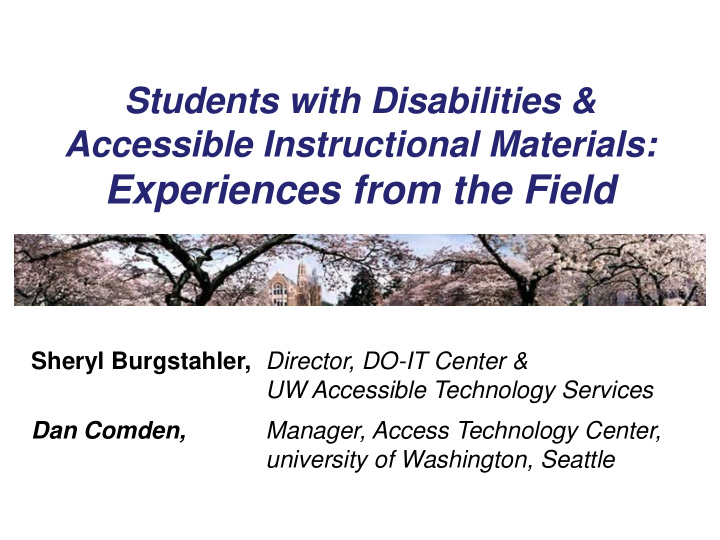



Students with Disabilities & Accessible Instructional Materials: Experiences from the Field Sheryl Burgstahler, Director, DO-IT Center & UW Accessible Technology Services Dan Comden, Manager, Access Technology Center, university of Washington, Seattle
Disabilities, Opportunities, Internetworking, & Technology • 1992, grant from U.S. National Science Foundation • Now DO-IT Scholars program funded by State of Washington • Other grants fund special projects
DO-IT Goal To increase the success of individuals with disabilities in Postsecondary education & careers, using technology as an empowering tool
Disabilities related to: • Hearing • Seeing • Learning • Attention • Health • Speech • Mobility, physical skills • Communication , …
Challenges for students: • Diminished support systems after high school • Little access to successful role models • Lack of access to technology that can increase independence, productivity, & participation • Inadequate self-advocacy skills • Inadequate accommodations, including obtaining materials in accessible formats • Low expectations & other negative attitudes on the part of people with whom they interact – National Organization on Disabilities
Sources of Evidence for Project Interventions • Literature review • Outcomes of prior projects • Suggestions from practitioners • Input from students with disabilities
Alliances to increase degree attainment of students with disabilities in science, technology, engineering & mathematics (STEM) in computing fields
Ultimate Impact • Make academic & career opportunities available to more citizens. • Enhance fields of study/employment with the talents & perspectives of people with disabilities.
Alliance activities promote: 1. Student success 2. Institutional change 3. Knowledge dissemination
1. Student Engagement • Computer, science transition lectures, workshops • Field trips • College & career prep • Tutoring • Networking • Internships • E-mentoring • Self-determination, leadership opps
Critical Junctures
International Exchanges Between DO-IT U.S. & DO-IT Japan
• Two U.S. DO-IT Scholars to Japan to share experiences & tips for success with Japan Scholars. • Japan & U.S. Scholars communicate in electronic video conferences & Second Life.
Perspectives of Students Regarding Accessible Materials • Publishers don ’ t provide books in accessible format at all or in timely manner. • Instructors don ’ t choose materials early enough to get produced in accessible format; post materials online in inaccessible formats • The institution takes too long to produce materials in accessible formats
2. Working with Institutions We promote universal design & effective accommodations
Accommodation = Alternate format, service, &/or adjustment for a specific individual
“ Coffeepot for Masochists ” , Catalog of Unfindable Objects by Jacques Carelman; in Donald Norman ’ s The Psychology of Everyday Things , 1988
Universal Design = “ the design of products & environments to be usable by all people, to the greatest extent possible, without the need for adaptation or specialized design. ” The Center for Universal Design www.design.ncsu.edu/cud
In Postsecondary Institutions, UD Can be Applied to: • Instruction/Learning Environments & Instructional Materials • Student Services • Information Technology • Physical Spaces
We Promote UD as: • An attitude that values diversity, equity, & inclusion • A goal • A process • Practices that make learning materials & environments welcoming , accessible , & usable for everyone
Examples of UD Practices • Arrange seating so that everyone has a clear line of sight • Use large, bold fonts on uncluttered overhead displays & speak aloud all content presented • Provide multiple ways to gain & demonstrate knowledge • Avoid unnecessary jargon ; define terms • Provide scaffolding tools (e.g., outline)
Examples of UD, continued • Buy lab products that can be used by individuals with wide range of abilities • Address safety procedures for students with wide range of abilities • Address a variety of reading levels & language skills • Provide materials in accessible electronic formats, including symbols & figures
Conclusion, We need: • Universal design (proactive for everyone) & accommodations (reactive for individuals) • Policies & procedures that address both
3. Searchable Knowledge Base www.uw.edu/doit • Q&A: Where can I find electronic text versions of books for students who have visual impairments or other print disabilities? • CASE STUDY: Earth Science: A Case Study on Teaching Concepts to a Student with a Visual Impairment • PROMISING PRACTICE : Accessibility Reviews: A Promising Practice to Improve the Accessibility of Local Science Education Programs
Accessibility at UW • Work with developers for accessible web sites and apps • Networked screenreader available for testing • Site template, Catalyst, other tools
(image of online form for Braille submission removed.) • Find at: http://www.washington.edu/itconnect/acce ssibility/atl/braille.html
(image of UW ATC entrance removed)
(image of alternate keyboards at UW ATC removed)
AIM at U of Washington • High speed scanning, Braille, tactile graphics • Disability Resources for Students: publisher contacts – MS Word, PDF format • Facilities & training for independent PDF conversion • Ubiquitous AT for reading
(image of students in computer lab removed)
Research • Android accessibility – CSE Capstone • AIM Research Group – iSchool • Tactile Graphics – CSE and ATC
Tactile Graphics Diagram of human eye Computer-embossed from textbook tactile diagram with Braille labels 32
Graphic Translation <LocationInformation> <NumLabels>16</NumLabels> <Resolution>100.000000</Resolution> location <ScaleX>1.923077</ScaleX> <ScaleY>1.953125</ScaleY> file - <Label> <x1>121</x1> preprocess text extract <y1>45</y1> <x2>140</x2> <y2>69</y2> <Alignment>0</Alignment> <Angle>3.141593</Angle> </Label> original clean pure scanned image graphic image text image 33
Graphic Translation <LocationInformation> <NumLabels>16</NumLabels> <Resolution>100.000000</Resolution> <ScaleX>1.923077</ScaleX> <ScaleY>1.953125</ScaleY> location - <Label> file <x1>121</x1> <y1>45</y1> <x2>140</x2> <y2>69</y2> <Alignment>0</Alignment> <Angle>3.141593</Angle> </Label> y pure (0,20) y x=15 (#0,#20) graphic 15 x.k#15 10 #15 text Braille 5 #10 O #5 x O text 5 x 10 #5 image 15 #10 20 #15 20 #20 x+y=20 #20 (15,0) x+y.k#20 (15,5) (#15,#0) (#15,#5) 34
Questions - Comments - Discussion Tactile Graphics: tactilegraphics.cs.washington.edu DO-IT: www.uw.edu/doit/
Recommend
More recommend